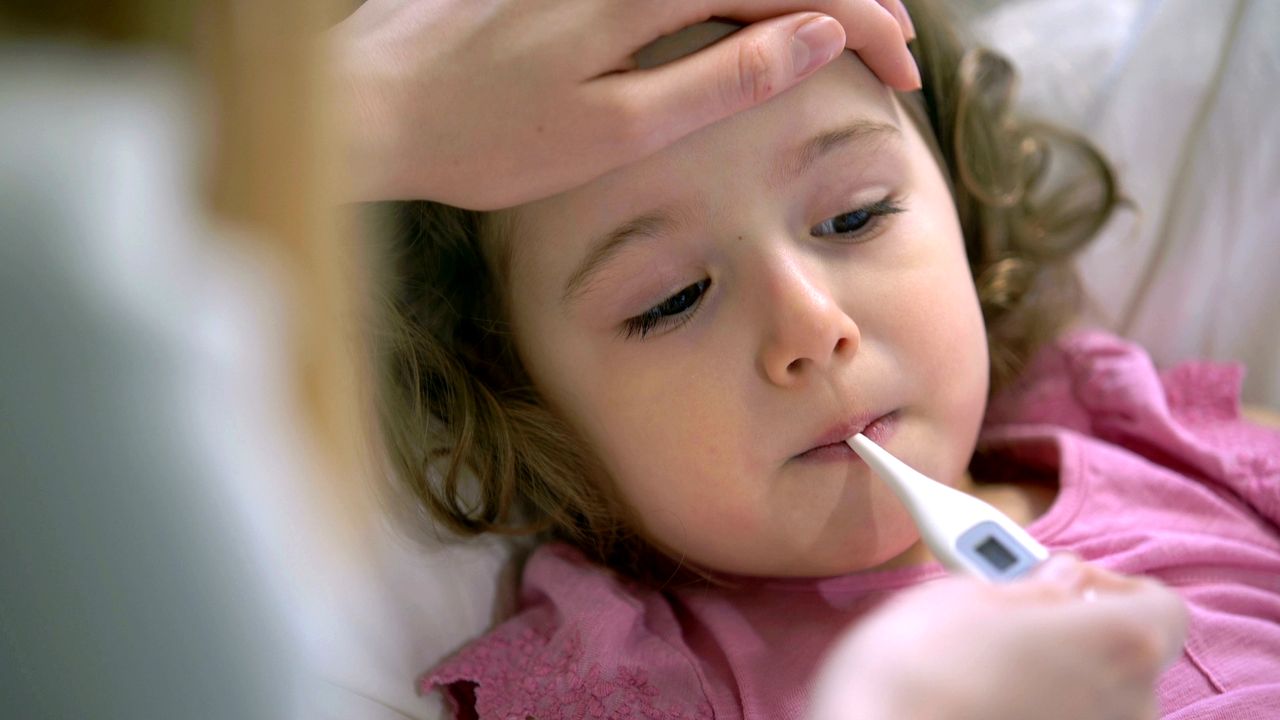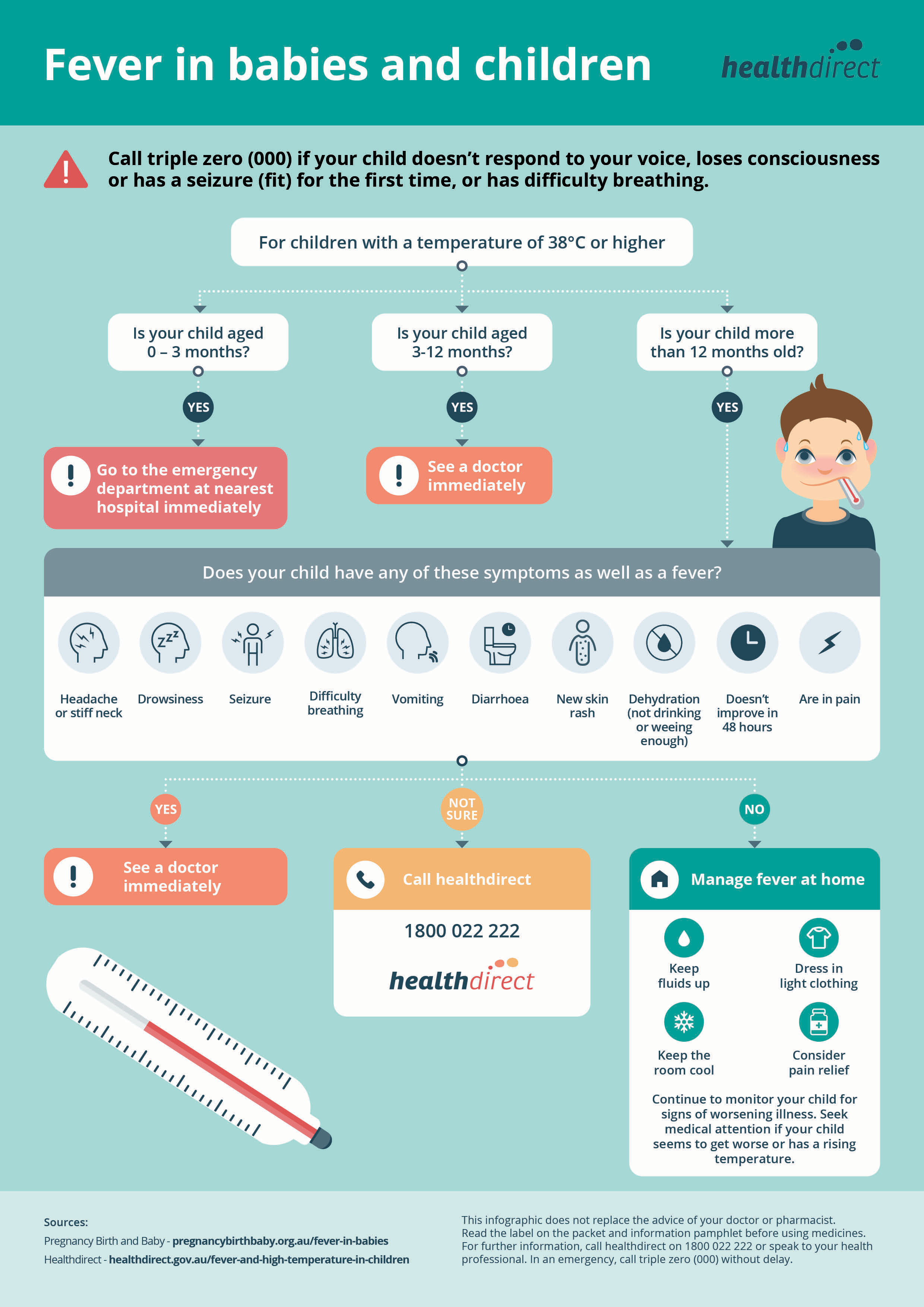
Key facts
- Fever is common in children.
- Fevers are usually caused by viral infections.
- If your child has a fever, they will have a high temperature and may also be flushed, shivering or sweating.
- You can make your child with a fever more comfortable by keeping them cool, dry and rested.
- If your child with a fever is under 3 months old, seek medical attention.
What is a fever?
A fever is a temperature of 38°C or higher.
Fevers are quite common in young children and are usually mild. Sometimes the causes of a fever will need urgent attention, but in most cases they can be managed at home.
What symptoms are related to fever in children?
or sit amet, consectetur adipiscing elit. Ut elit tellus, luctus nec ullamcorper mattis, pulvinar dapibus leo.
Fever itself is rarely harmful. Your child may have a fever if:
- their face is hot to the touch
- they look red or flushed
The high temperature may make your child feel uncomfortable.
A fever can cause other symptoms such as:
- chills or shivering when their temperature is rising
- sweating when their temperature is falling
- vomiting
- discomfort
What causes fever in children?
Fever is one of the ways your body fights infection.
Infections are by far the most common cause of fever in children. Most of these are caused by viruses, which are responsible for:
- colds
- the flu
- COVID-19
These infections don’t last long and usually don’t need to be treated.
Some infections are caused by bacteria and need treatment with antibiotics. These include:
- certain ear and throat infections
- urinary tract infections
- pneumonia
- blood infections such as meningitis
You need to see a doctor if you think your child has any of these infections.
When should I take my child to see a doctor?
You generally don’t need to see a doctor if your child is:
- over 3 years old
- not too sick despite the fever
Some symptoms that appear when a child has a raised temperature require urgent attention. You should call triple zero (000) and ask for an ambulance if you notice that your child:
- is drowsy
- is having difficulty breathing
- has a stiff neck
You should also see or contact your doctor straight away if you are concerned, or if your child:
- is over 6 months and shows other signs of being unwell
- is floppy and drowsy
- is vomiting
- has ongoing headaches
- has ongoing tummy pain
- the light is hurting their eyes
- the fontanelle (soft spot on your baby’s head) is bulging
- is not taking fluids well
- has had the fever for more than 3 days
- has travelled or been in contact with someone with a serious infection
If your baby is under 3 months of age and they have a fever, take them straight to a doctor. If a doctor is unavailable, go to the nearest hospital emergency department.
How is fever diagnosed in children?
To see if your child has a fever, you can check their temperature with a thermometer.
A normal temperature in children is 36.5°C to 38°C although it depends on:
- the person
- their age
- what they have been doing
- the time of day
- the part of the body where you take their temperature
Body temperature is usually lowest in the early hours of the morning. It’s usually highest in the late afternoon and early evening.
A doctor can also diagnose the cause of your child’s fever.
How do I treat my child if they have a fever?
Most causes of a raised temperature in a child are usually not serious and can be managed at home.
A fever will run its course regardless of treatment. Your child’s temperature will return to normal when the infection or other cause of the fever has completely gone.
Babies under 3 months are most at risk of fever complications. If your child is under 3 months, with a fever, get medical advice.
Generally, children handle fever well. However, if your child has a fever, here are some ways to make them more comfortable:
- Dress them in light clothing to keep them cool.
- Cover them with a sheet if they are shivering.
- Keep the room at a comfortable temperature by adjusting the heating or opening a window.
- Give them plenty of cool, clear fluids to drink. Give extra breastfeeds, formula or cool boiled water if your baby is under 6 months.
- Wipe their head with a warm sponge or facecloth.
Cool baths, sponges and fans are not recommended. They may make your child uncomfortable, or too cold.
Don’t worry if your child isn’t hungry. The most important thing is to make sure they are drinking enough to avoid dehydration.
Fever medicines
There is no need to give medicines to a child for fever unless they are in pain or discomfort.
Paracetamol can be given to children aged 1 month or older for pain and symptoms of fever. Make sure you have the right strength for your child’s age and weight since overdosing can be dangerous. Read and follow the directions on the label carefully. If you are not sure, check with your doctor or pharmacist.
Ibuprofen can be given for pain and symptoms of fever in children who are 3 months or older.
Avoid ibuprofen if your child has asthma, unless your doctor tells you differently.
Don’t give aspirin to children under 16 years unless it’s specifically prescribed by a doctor.
Can fever be prevented?
Lowering or preventing your child’s fever won’t help treat the underlying cause of fever.
Complications of fever
You can prevent complications by monitoring your child’s symptoms and seeking medical attention if needed.
Febrile convulsions are seizures (fits) that happen because of a fever. They usually happen when your child’s temperature rises quickly.
Febrile convulsions occur in about 1 in every 30 children between the ages of 6 months and 6 years. Most children who have a febrile convulsion won’t ever have another one.
Febrile convulsions have no long-term consequences, but you should talk to your doctor about them.
During a seizure your child will likely:
- lose consciousness
- become stiff
- become red or blue in the face
The seizure may last for a few minutes. Your child will usually be drowsy or irritated afterwards.
During a seizure, you should put your child in the recovery position. It’s also important to ensure that they don’t overheat.
You should call an ambulance if:
- it’s your child’s first seizure
- the seizure lasts for more than 5 minutes
- your child’s seizure ends but they don’t wake up
- your child looks unwell when the seizure ends





